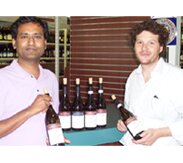Sun 7 Jun 2009
In an interview, which we did after tasting these wines with winemaker Alfio Cavallotto, he gave his impressions and comments about them. With his permission, we have paraphrased his thoughts and comments along with parker tasting notes to share with you.

‘Mahesh Lekkala, owner of Wine Legend with Alfio Cavallotto of Cavallotto
winery’
CAVALLOTTO, DOLCETTTO D’ALBA, VIGNA SCOT, 2007
‘Wine for everyday. A DOC, a single vineyard wine Vigna Scot. Perfect with light salamis and antipasti. Great for drinking with tomato based dishes like pizza and pasta because it has a lower acidity and can balance the acidity levels in the dishes.’ Alfio Cavallotto
CAVALLOTTO, BARBERA D’ALBA, BRICCO BOSCHIS, VIGNA DEL CUCOLO, 2005 ‘Single vineyard, Vigna del Cucolo’s grapes grow on the west side of the vineyard. This is Classic Barbera, aged in large Slovenian oak barrels, same as used for Barolo. Average age of this wine is 24 months in barrel. Not easy to find classic Barbera as it is expensive due to the barrel aging process, and this Barbera is both barrel aged as well as being a single vineyard wine. In the order of Piedmontese wines, Barbera falls in between Dolcetto and Barolo. Great when served with ravioli filled with mushrooms or red meats.’ Alfio Cavallotto
 CAVALLOTTO, NEBBIOLO, LANGHE, 2007
‘Grapes come from the Barolo zone, and is actually declassified Barolo. Only in vintages where the grapes don’t meet Barolo standards, the same juice becomes declassified as Nebbiolo, Langhe. Grapes from younger vines are used in this wine as well.’
CAVALLOTTO, BAROLO, BRICCO BOSCHIS, 2004
‘Made from three vineyards in the Bricco Boschis Cru.
This is the ‘most important wine for them, producing approximately 24,000 bottles each vintage.’ This is their signature bottling. Classic, long maceration, long aging in Slovenian barrels for three years and six months. Pairs well with red meats and aged cheeses such as Parmigiano Reggiano, and elegant and lighter courses like grilled seafood: prawns and lobster. The vineyard soil is clay and sand as well as layers of both. This produces ‘aromatics, which are more floral and open.’
“The 2004 Barolo Bricco Boschis tastes just like it did from barrel, which is to say sweet, layered and totally irresistible. The ripe red fruit is incredibly primary, and this wine is years away from offering its finest drinking, but it is already very impressive at this stage. This is an especially refined, elegant vintage for this wine, and I can only say that I await the Riservas with eager anticipation.”
 WINE ADVOCATE, 93 POINTS
CAVALLOTTO, BAROLO, RISERVA, VIGNOLO, 2001
”Another Cru, another family monopole.’ Soil different than in the Boschis Cru. Clay soil, which retains water, and in summer it is very dry, so this soil is good for the vines. Aromatic is more fruity and less floral. 5- 6 yrs of aging in Slovenian oak. These are old vines, which are approximately 50 or more years of age.Â
 ”The 2001 Barolo Riserva Vignolo is a terrific effort. This elegant, refined wine presents expressive, perfumed aromatics and sweet red fruit, with notable persistence and delineation on the palate. It is a finessed, superbly poised Barolo that will benefit from another few years of bottle age to soften the tannins, even if it is surprisingly accessible as well as irresistible today. 92/Anticipated maturity: 2011-2021.â€
 WINE ADVOCATE, 92 POINTS
CAVALLOTTO, BAROLO, BRICCO BOSCHIS, RISERVA, VIGNA SAN GUISEPPE, 2001 ‘Particular selection of grapes exclusively from old vines. Average age of vines is 50 years old, with some being more than 70 years old. Grapes are sourced from the best part of the Bricco Boschis Cru. These are their oldest vines. This is an important wine for them. Very limited production, only 13,330 750ml bottles a year produced. Limited quantities of magnums and double magnums are available. In every vintage a portion of the grapes from this vineyard go into the Bricco Boschis Barolo.’ “The 2001 Barolo Riserva Bricco Boschis Vigna San Giuseppe is captivating. Made in a dark, brooding style, it reveals a deeply layered personality that marries richness to depth, with generous tar, smoke, menthol, spices and sweet black cherries. As expected, it comes across as much more powerful and structured than the 2001 Vignolo tasted alongside it. Still an infant, the 2001 Vigna San Giuseppe is a wine to buy and forget about for several years if not considerably longer. It may very well be the finest Barolo Cavallotto has ever made, and it is not to be missed. Anticipated maturity: 2013-2026.”
 WINE ADVOCATE, 95 POINTS







